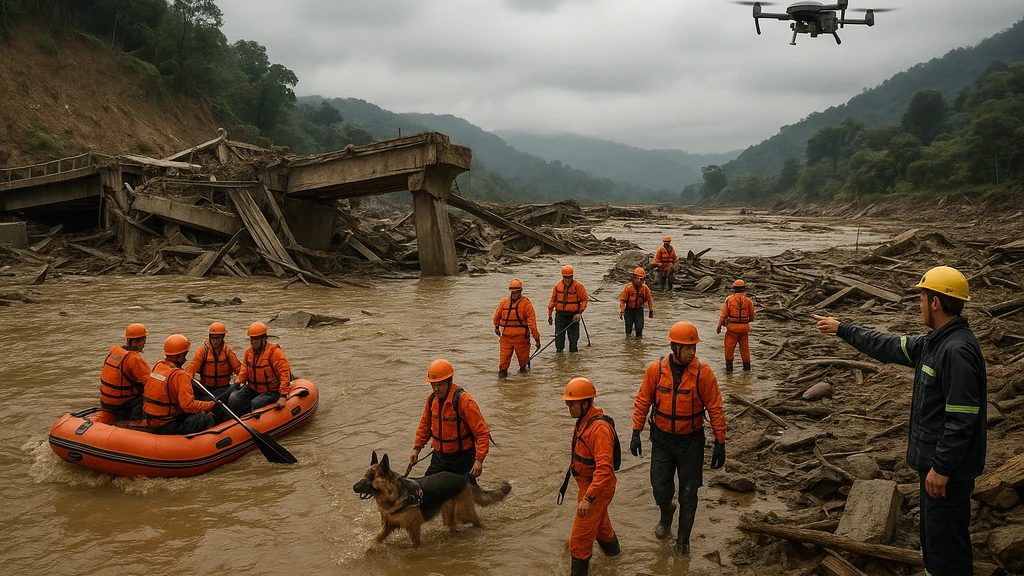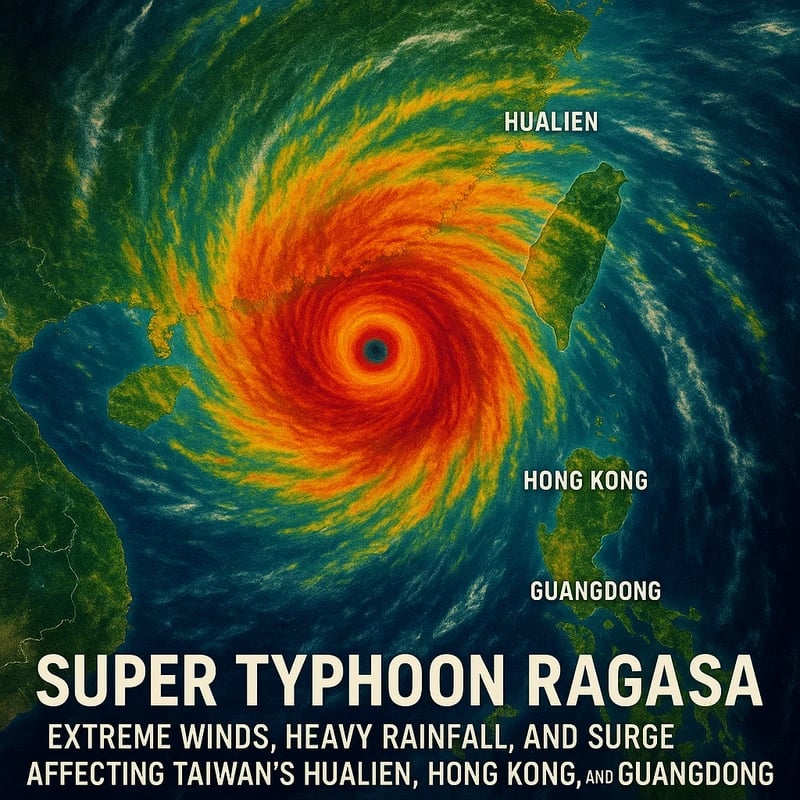Super Typhoon Ragasa unleashes fierce winds and floods across Taiwan, Hong Kong, and Guangdong - see evacuations, rescues, and region resilience today.
Quick Answer
Super Typhoon Ragasa stands as the year’s strongest cyclone, leaving Taiwan’s Hualien coastline under rescue mud and Hong Kong in rapid recovery mode after a record-long T10 warning. In Taiwan, at least 14 people are confirmed dead with dozens missing as barrier-lake failures sent surging waters through Guangfu. Hong Kong has cleared thousands of trees and resumed flights, while millions in southern China evacuated in advance of Ragasa’ landfall in Guangdong. The storm’s ferocity highlights how warmer oceans are empowering faster, rain‑heavy cyclones, prompting new safety priorities across Asia.
Key Takeaway: Ragasa’s aftermath is driving urgent fixes in disaster response, urban resilience, and regional climate adaptation across Taiwan, Hong Kong, and southern China.
Complete Guide to Super Typhoon Ragasa
A symphony of wind, rain, and remaking landscapes, Super Typhoon Ragasa swept across the Western Pacific with an intensity rarely seen in recent decades. For residents of Taiwan, the immediate test was survival and rescue; for Hong Kong, it was transition from alert to rebuilding; for southern China, it was sustained evacuation and flood management. Across the region, Ragasa’ path—lashing Taiwan, skirting Hong Kong, pressing into Guangdong—became a case study in the climate-change era’s hazards.
Overview and scale
- Ragasa is described as the world’s most powerful tropical cyclone of 2025, with sustained winds reaching extreme levels and a vast surge footprint. In coastal towns and inland valleys alike, the assault produced accumulative rainfall, mudslides, and inundation in low-lying zones.
- In Taiwan’s Hualien County, rescuers faced barrier-lake failures and dense mud. The operation involved cutting through rooftops and wading waist-deep sludge to reach the missing, while downstream communities prepared for further aftershocks of the flood.
Rescue operations in Taiwan: Ragasa Taiwan rescue efforts
-
The most urgent searches centered on Guangfu, where a barrier lake breach unleashed a wall of water. Crews navigated collapsed infrastructure, with multiple teams coordinating drone reconnaissance, canine units, and improvised watercraft.
-
Official tallies reported at least 14 deaths and dozens more unaccounted for, a figure that underscores the scale of the disaster in Hualien and neighboring townships. Local authorities warned that the mud and unstable debris could slow recovery for days.

-
The Ragasa rescue narrative in Taiwan also highlighted the strain on emergency services, the fragility of rural drainage systems, and the importance of rapid, coordinated responses across county lines.
Hong Kong recovery: Ragasa Hong Kong recovery
- Hong Kong issued its longest-ever T10 signal during Ragasa, lasting 10 hours and 40 minutes, before the city moved to a recovery posture. The transition included re-opening schools, restoring limited flight operations, and resuming public transit as conditions allowed.
- By late week, more than 1,000 downed trees had been cleared, and air and rail links gradually returned to near-normal operations. The city’s resilience program emphasized flood-prevention maintenance, debris clearing, and damaged-district assessments to inform rebuilding plans.
- The Ragasa footprint in Hong Kong also illustrated the tension between urban density and storm drainage capacity, especially in Kowloon and new towns where tree canopies and aging infrastructure intersect during extreme rainfall events.
Southern China evacuations and Guangdong landfall: Ragasa Guangdong landfall
- Ragasa’s outer bands and surge surged into Guangdong, prompting mass evacuations across coastal counties and river basins. Authorities directed residents away from vulnerable shorelines and flood-prone zones, while emergency centers prepared to receive residents from nearby municipalities.
- Officials reported that millions were evacuated or displaced regionally as Ragasa moved inland. The storm’s slow movement and rain-laden nature amplified flood risks, complicating shelter logistics and sustained emergency operations.
- The Guangdong landing also tested cross-border coordination with Hong Kong and Macau, as well as regional meteorological collaboration to issue timely warnings and coordinate evacuation advisories.
Climate context: Ragasa and warmer oceans
- Experts emphasize Ragasa’ intensity as part of a broader pattern linked to rising sea surface temperatures. Warmer oceans fuel higher wind speeds, greater storm draught, and heavier rainfall—combining to create slower-moving, rain-heavy cyclones with significant surge potential.
- Climate-adaptation researchers note that infrastructure—coastal barriers, drainage networks, and emergency communication—must evolve to mitigate Ragasa-like events in the coming years. Data from the last quarter point to a spike in high-impact storms across the region, aligning with broader climate trends.
- The Ragasa narrative underscores the need for resilience investments: early warning systems, community-based evacuation planning, and climate-smart urban design to reduce exposure in high-risk zones.
Ragasa and the broader humanitarian response: Ragasa Bualoi link
- A second system, Typhoon Bualoi, has brought deadly flooding to parts of the Philippines and is tracking toward Vietnam, adding humanitarian pressure to a regional emergency context already stretched by Ragasa.
- The overlapping crises demand integrated disaster response: shared logistics, cross-border relief corridors, and transparent information flows to ensure that affected populations receive timely aid.
- This complex patchwork—Ragasa in Taiwan and Hong Kong’s recovery, Ragasa’s spillover into southern China, and Bualoi’s broader Southeast Asian footprint—calls for regional resilience strategies that connect urban planning, climate science, and humanitarian logistics.
Practical applications for resilience and response
- Early-warning reliability: strengthening meteorological networks and disseminating warnings through multiple channels to reduce exposure time for residents in risk zones.
- Barrier-lake and dam safety: conducting rapid assessments of barrier lakes and flood-control structures after major typhoons to prevent catastrophic failures.
- Urban drainage optimization: investing in flood-resilient urban design, permeable surfaces, and rapid debris clearance to minimize inundation symptoms in cities like Hong Kong.
- Cross-border coordination: enhancing information-sharing, joint drills, and mutual aid agreements to improve regional readiness in future Ragasa-like events.
Key Takeaway: Ragasa’ aftermath demonstrates how a multi-country response—bolstered by meteorology, infrastructure resilience, and regional cooperation—must evolve to protect communities from faster, wetter storms.
Why This Matters
In the wake of Ragasa, the regional conversation centers on climate-informed adaptation and risk-reduction—lessons that extend beyond any single storm. For Asia, Ragasa underscores the shift toward more intense rainfall, larger surge footprints, and longer-lasting post-storm disruption, all of which affect millions of lives and regional economies.
Recent developments and trends
- Climate signals point to warmer seas fueling stronger typhoons, with data showing a rise in high-intensity events in the Western Pacific over the past three years. Ragasa embodies this trend, delivering a stark demonstration of how extreme winds and flood-prone terrain intersect in densely populated coastal zones.
- Governance and planning responses are accelerating: more frequent pre-storm evacuations, better sheltering capacity, and targeted flood-control investments are now central to regional resilience plans.
- Data-driven risk assessments are becoming standard: municipalities are layering hazard maps with social vulnerability indicators to ensure that aid reaches the most at-risk groups during Ragasa-like events.
Expert insights and data highlights
- Climate scientists emphasize that even modest shifts in sea-surface temperatures can magnify storm intensity and rainfall totals, increasing the probability of barrier failures and urban flooding in riverine corridors.
- Emergency-management leaders stress the importance of maintaining air, maritime, and land corridors for swift relief, as well as robust communication strategies that reach rural communities with limited connectivity.
- Economists warn that the cost of inaction compounds over time, as repeated extreme events disrupt supply chains, housing markets, and social stability in the region.
Public policy implications
- Strengthening early-warning dissemination, including mobile alerts and community sirens, to ensure timely action by vulnerable populations.
- Upgrading flood defenses, drainage networks, and barrier lakes to withstand the surge and mudflow that Ragasa-like storms produce.
- Preparing for multi-hazard events, where storms coincide with landslides, riverine flooding, and power outages, requiring integrated emergency planning.
Key Takeaway: Ragasa is not just a weather story; it is a catalyst for climate-smart policy, infrastructure upgrades, and regional cooperation that will shape Asia’s safety landscape for years to come.
People Also Ask
What is Super Typhoon Ragasa?
How many people were killed by Ragasa in Taiwan?
Why did Hong Kong issue a T10 warning for Ragasa?
Where did Ragasa make landfall?
Which areas were evacuated because of Ragasa?
What is Typhoon Bualoi and how is it related to Ragasa?
How long did Ragasa affect Hong Kong?
How did Ragasa affect southern China evacuations?
What were the main damages caused by Ragasa in Taiwan?
What lessons does Ragasa teach about disaster preparedness?
Key Takeaway: The Q&A snapshot helps readers quickly answer common queries about Ragasa while guiding them toward deeper sections of the guide for context, data, and implications.
Related topics for further reading and internal exploration
- Climate-resilient infrastructure and urban flood management
- Disaster response coordination and cross-border relief
- Coastal barrier design and maintenance
- Meteorological tracking and risk communication
- Community-based adaptation and social vulnerability analysis
- Post-disaster economic recovery planning
Key Takeaway: Ragasa connects to a broader set of topics—climate resilience, disaster diplomacy, and urban design—that matter for policymakers, researchers, and communities preparing for the next big storm.
Next steps for readers
- Monitor official briefings from meteorological agencies for Ragasa’s latest trajectory and intensity updates.
- Review local evacuation and shelter policies if you live in a Ragasa-affected area.
- Explore region-wide resilience plans and how they address barrier-s lake safety, urban drainage, and emergency logistics.
Key Takeaway: The Ragasa moment invites active engagement—from individual preparedness to regional policy reform—so that communities are better shielded against future wind, rain, and flood events.
Overall, Super Typhoon Ragasa is more than a headline—it is a turning point that tests courage, design, and cooperation across Taiwan, Hong Kong, and southern China. The aftermath invites not just relief but reimagination of resilience in a warming world.



